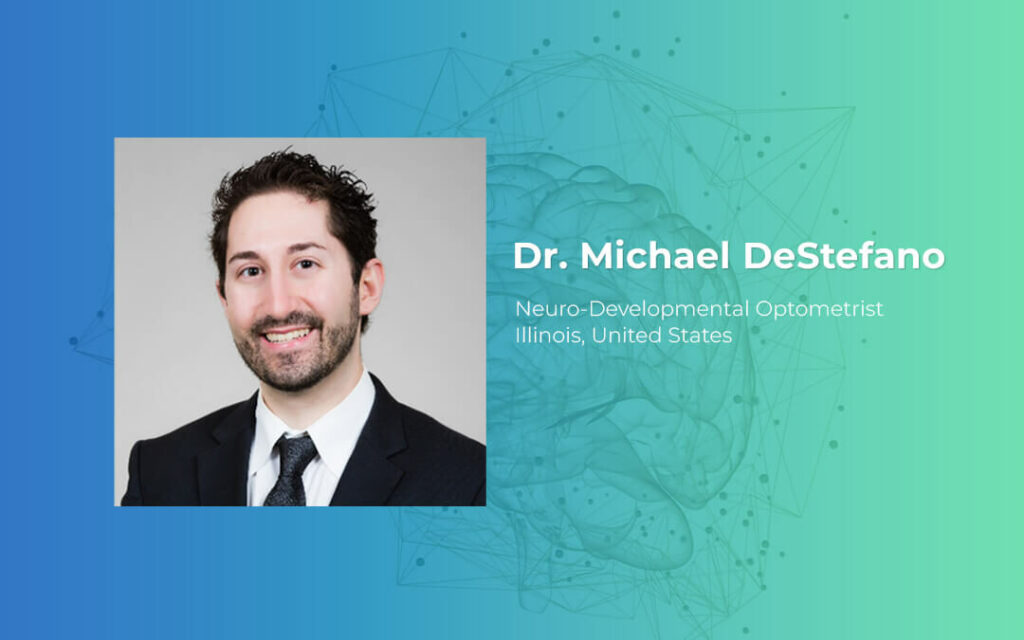Dr. Michael DeStefano
Meet Dr. Michael DeStefano, a Neuro-Developmental Optometrist based in Arlington Heights, Illinois, who specializes in both developmental & neurological medical cases.
As a Neuro-Optometrist, Dr. DeStefano works with various populations, including but not limited to patients with Autism, Down Syndrome, and vision problems that impact learning. Dr. DeStefano also performs regular eye exams for children and offers myopia control, slowing down nearsightedness progression.
His significant amount of experience has also been gained from working with patients who present with neurological conditions causing visual disturbances. Post-Concussion Syndrome, Post-Stroke Syndrome, and Visual Snow Syndrome are among the most common neurological conditions he treats.
How did you first hear about Visual Snow Syndrome?
“There’s not a single pattern, but I’ve seen a lot of different correlations with the onset of Visual Snow Syndrome: It’s really complex, and there’s not one single common denominator with all of them,” mentioned Dr. DeStefano.
“I learned about it through my professor who suffered from the condition,” states Dr. DeStefano.
Dr. DeStefano’s professor had been hit by a car as a pedestrian and suffered a Traumatic Brain Injury (TBI), eventually developing Visual Snow Syndrome.
“She told us about her experience with the condition and how it impacted her life. This was not part of the curriculum in optometry school, but it piqued my interest, and I started learning more about it,” says Dr. DeStefano.
As an optometry student, Dr. DeStefano was always interested in vision therapy and Neuro-Optometry and got to learn more through his professor on VSS diagnosis, symptoms, and treatment options such as therapy & tinted lenses. Dr. DeStefano went on to do further reading and speaking with his colleagues during his clinical rotations and internships, where he gathered and learned more information on what has and has not worked for patients.
What sort of patients consult you about Visual Snow?
“There’s not a single pattern, but I’ve seen a lot of different correlations with the onset of Visual Snow Syndrome: It’s really complex, and there’s not one single common denominator with all of them,” mentioned Dr. DeStefano.
Dr. DeStefano’s Visual Snow Syndrome patients present symptoms such as static vision, light sensitivity, double vision, eyestrain, headaches, difficulty with reading, general fatigue, motion sensitivity, dizziness, and vertigo.
What is your approach with a Visual Snow Syndrome patient?
“There’s not a single pattern, but I’ve seen a lot of different correlations with the onset of Visual Snow Syndrome: It’s really complex, and there’s not one single common denominator with all of them,” mentioned Dr. DeStefano.
“I like to get a really good case history because Visual Snow Syndrome presents many different symptoms, and every patient is different,” states Dr. DeStefano. Once Dr. DeStefano understands the patient’s case history and how it’s affecting their daily life, he would then proceed to a comprehensive eye examination.
Based on the results of the examination and the visual-motor/visual processing assessment, Dr. DeStefano develops a personalized treatment plan for the patient. This could involve exercises and activities to help improve their visual processing, eye coordination, eye aiming and any other necessary treatments for any underlying vision problems.
He also has a unique device called the Cerium Intuitive Colorimeter that allows patients to manually explore the visible spectrum and select a color and level of opacity/transparency that provides the greatest amount of symptom relief.
“I like to try it with everybody at least, and what it does is it lets the patients see the tint sample in real-time, they can adjust the color manually, and it illuminates black text on a white background. So the patient can see what it’s like looking at paper with it,” mentions Dr. DeStefano.
Message to the VSS Community
“I definitely believe there’s reason for hope. If you haven’t tried everything that is available, I believe it’s worth exhausting all of your options. There is a lot to try out there. Even after you’ve exhausted all of your options, and if you haven’t experienced improvement yet, that isn’t necessarily to say that something will not come up in the future. There are other things that I am confident will be developed in the future to help people with Visual Snow Syndrome” – Dr. Michael DeStefano.
Dr. Michael DeStefano Contact Information:
Email: DrDeStefanoOD@Gmail.com
Website: visualsymptomstreatmentcenter.com
Clinic: Visual Symptoms Treatment Center – Arlington Heights, IL


